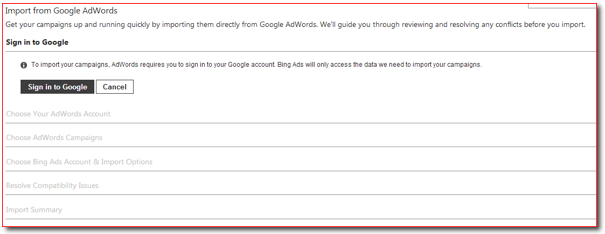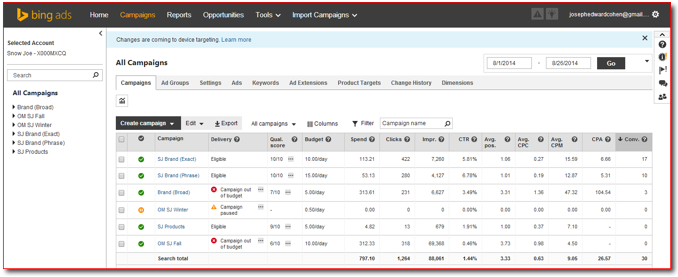Pay Per Click Advertising – An Introduction to Bing Ads
Bing Ads might be considered Google AdWords’ younger brother – it likes to mimic its older brother in every way, from interface to conversion tracking to keyword bidding methodology. While it falls short on many of the bells and whistles available in Google, Bing Ads can be a very useful tool for supplementing PPC results.
If you are spending money with Google AdWords for your lead generation or ecommerce site don’t forget to allocate some budget to Bing Ads. In many cases we found Bing Ads to have different results, and in some cases superior, to Google. The demographics may be different and can result in higher conversions rates and lower costs.
Establishing a Bing Ads Account
Creating a Bing Ads account is similar to creating an AdWords account. You need to create a Microsoft account first. We suggest using the same email address and password for Bing as you do for AdWords. This way you can easily log in to each account. If you don’t have someone managing the accounts for you, you will want to make sure to log in at least once every 2 days, but preferably every day, to watch over and micro-manage the account.
Although you can set budgets like you can with Google, it is important not to “set it and forget it.” Spending might be limited based on the budget, but you really want to control where you allocate your budget to make sure it is going to the keyword topics that provide the most return on investment (ROI).
Google AdWords Import
Perhaps one of Bing Ads’ smartest features is its seamless ability to let you import campaigns directly from Google AdWords. You simply provide account login details, and Bing will let you pick and choose which campaigns from Google to import. Bing will even customize the tracking codes you have on ad destination URLs. If no tracking codes are on your PPC ad destination URLs, then you will want to make sure you add them.
The reason to add the tracking codes is that although Google AdWords and Google Analytics are seamlessly integrated, Bing Ads are not recognized as a traffic referrer in Google Analytics. Instead, Google Analytics will lump all clicks from Bing—paid and unpaid—as “Bing Organic,” which does not allow you to differentiate between paid and non-paid traffic from Bing. For obvious reasons, doing so can be a highly effective method for measuring ROI of your Bing Ads campaigns.

Figure 1: The “Import from Google AdWords” tool within Bing Ads allows you to seamlessly import any and all campaigns from Google into your Bing Ads account, saving you tremendous time and effort.
Conversion Tracking
Like AdWords, Bing Ads tallies conversions (orders, contact requests, etc.) through a conversion code snippet that must be added to a confirmation page – i.e. the thank you page that loads after an order is placed or lead form is submitted. This small block of JavaScript code needs to get added to that page’s source code, somewhere above the closing tag. Then, when a Bing Ads PPC ad is clicked and the user converts on your site, Bing Ads can tally the conversion in your account, and tie it directly to the referring keyword.
When managing your campaigns, the ability to determine which keywords are converting into new customers or leads can be extremely helpful when determining a) the ROI of each campaign and b) how to effectively allocate your budget moving forward.
Bing Ad’s Shiny, New Interface
Bing recently updated its interface to mirror Google AdWords’ interface. All campaigns can now be accessed in the left column, like on Google, and the campaign settings can be modified via the tabbed menu on the right. Below that, campaign summary details can be viewed and customized. This new look allows for much easier navigation to the various parts of the account, and allows for easier management of the settings, as on Google.

Figure 2: Bing Ads’ new interface mirrors the Google AdWords interface, allowing for easier management.
How to Budget for Bing
When carving up your monthly advertising budget, we like to suggest allocating a small percentage of the budget (say, around 20%) to Bing Ads. And we always suggest implementing this at least one month after launching Google AdWords. The reason is that the experience we gain from running AdWords for 30 days can offer valuable insights into what might work for Bing Ads.
It’s important to note that the volume on Bing is far less than on Google. Even though Bing Ads supplies paid search results for both the Bing and Yahoo search engines, they still capture only a minority of the overall search market.
Summary of Unavailable Features
Google AdWords is a very robust advertising tool. Its use gains you access to a large network of websites where Google Ads display, including banner ads on other websites, remarketing ads shown to users who previously visited your site, and Google Shopping ads that display your ecommerce products. Bing Ads, however, does not offer the same robust set of features as AdWords. For example, these features are not yet available in Bing:
1) Robust Shopping feed integration to allow you to control your ecommerce product listings
2) Remarketing and Dynamic Remarketing functionality
3) Display/banner ads
Although Bing does have Bing Merchant Center, its features are secondary to Google’s more robust Shopping network for showing product ads and promoting different ecommerce offers. Similarly, although remarketing is technically available on the Bing (and Yahoo) platforms, these campaigns cannot be created in Bing Ads itself. Instead, you need to look to third party tools like AdRoll to run remarketing ads on the Bing network.
Conclusion
If you imagine that your advertising budget is like a pie, carved up into several pieces for each account, the Bing Ads piece would be on the small side (maybe 1-2 slices of the pies). But it would be just enough to wet your appetite! Thus, apportioning a percentage of your budget to Bing Ads, especially because of the AdWords import functionality, is a good idea and you may be surprised with some of the results.
Let us know if you need help reviewing your set up or would like to schedule a free discovery call!













